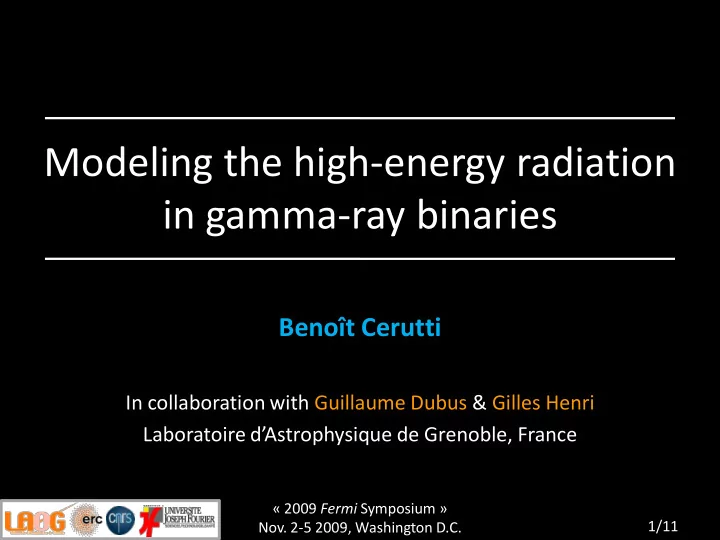

Modeling the high-energy radiation in gamma-ray binaries Benoît Cerutti In collaboration with Guillaume Dubus & Gilles Henri Laboratoire d’Astrophysique de Grenoble, France « 2009 Fermi Symposium » 1/11 Nov. 2-5 2009, Washington D.C.
Some binaries in the gamma-ray sky Extracted from TeVCat LSI+61°303 LS 5039 PSR B1259-63 HESS J0632+057 2 kpc 2.5 kpc 1.5 kpc 1.5 kpc Credit: NASA/DOE/Fermi LAT Collaboration ? 26.5 days 3.9 days 1240 days ? B. Cerutti 2009 Fermi Symposium 2/11
GeV & TeV beacons: The orbital modulation TeV GeV LS 5039 LS 5039 [Abdo et al. 2009] LSI +61°303 [Aharonian et al. 2006] LSI +61°303 [Abdo et al. 2009] Richard Dubois’ Talk!! [Albert et al. 2008] PSR B1259-63 o Orbital modulation GeV and TeV o Stable modulation Orbital effect [Aharonian et al. 2005] B. Cerutti 2009 Fermi Symposium 3/11
The pulsar wind nebula scenario: The big picture! High-energy [Maraschi & Treves 1981; Dubus 2006b] processes: γ Observer! Inverse Compton γ γ e ± Pulsar γ γ Synchrotron radiation B Massive e ± Star γ ZOOM Pair production e ± e + γ e - γ B. Cerutti 2009 Fermi Symposium 4/11
Modeling the high-energy radiation in LS 5039 Emission shocked wind γ EGRET Pulsar spin-down power [Dubus et al. 2008] HESS L P =10 36 erg/s γ Magnetic field at the shock Pulsar B=0.8 ± 0.2 G Injected electron index Fermi p=2 ± 0.3 Emission unshocked wind Strong spectral signature! [Cerutti et al. 2008] Low Lorentz factor or highly magnetized wind? Dominant contribution [Sierpowska-Bartosik & Torres 2008] B. Cerutti 2009 Fermi Symposium 5/11
Theoretical GeV & TeV modulation in LS 5039… + Cascades! Fermi [Abdo et al. 2009] Anti-correlation! GeV-TeV anti-correlation due to pair production [Dubus 2006a] HESS Computation of 3D pair cascade radiation with a Monte Carlo code, constraints: - Inclination : 40° - Max ambient magnetic field : 5 G - TeV emitter close to the pulsar [Cerutti et al. In preparation] B. Cerutti 2009 Fermi Symposium 6/11
… as one would observe in the gamma-ray sky! Fermi HESS B. Cerutti 2009 Fermi Symposium 7/11
New modeling challenges: LSI +61°303 seen by Fermi o GeV modulation : [Abdo et al. 2009] Max/Min close to periastron / apastron Cutoff! o Spectrum: Power-law + exponential cutoff at 6 GeV ! - Incompatible with γγ -absorption - Magnetospheric pulsar emission? - Signature unshocked pulsar wind ? … GeV-TeV link non trivial!! B. Cerutti 2009 Fermi Symposium 8/11
The pulsar wind nebula scenario: The big picture! [Maraschi & Treves 1981; Dubus 2006b] γ Observer ! γ Pulsar γ Massive Star ZOOM e ± B. Cerutti 2009 Fermi Symposium 9/11
GeV excess: Signature of the unshocked pulsar wind? [Aragona et al. 2009] Pulsar spin-down power EGRET L P > 10 37 erg/s MAGIC Electrons energy 10 3 < γ < 5×10 4 Injected electron index Fermi p=3.1 Periastron Apastron [Abdo et al. 2009] Shift in phase!? + 0.25 ?? B. Cerutti 2009 Fermi Symposium 10/11
Conclusions o Leptonic model can explain the general features but complex interplay between high-energy processes for: - Shocked / unshocked wind components - Anisotropic effects - Cascades o Fermi observations of LSI +61°303 : Modulation and cutoff spectrum challenge models Are there 2 different components at HE and VHE? Signature from an unshocked pulsar wind ? Acknowledgements to A.B. Hill, A. Lamberts & A. Szostek B. Cerutti 2009 Fermi Symposium 11/11
Recommend
More recommend